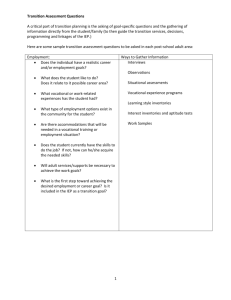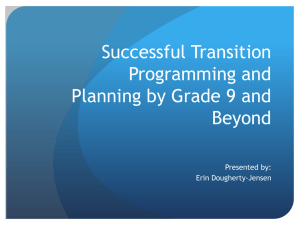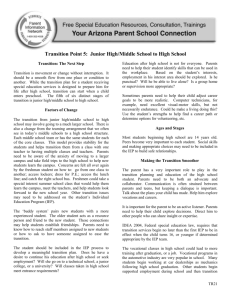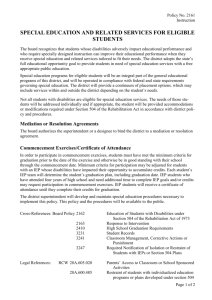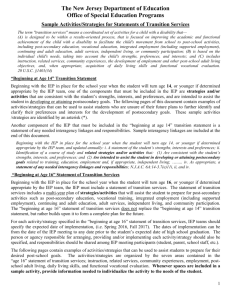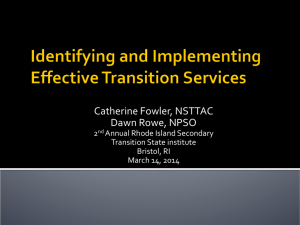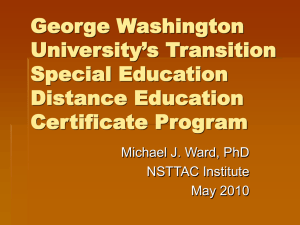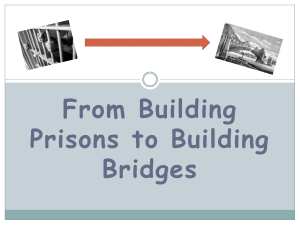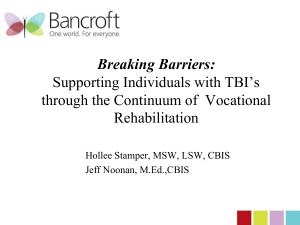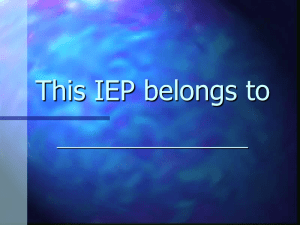What is Transition
advertisement
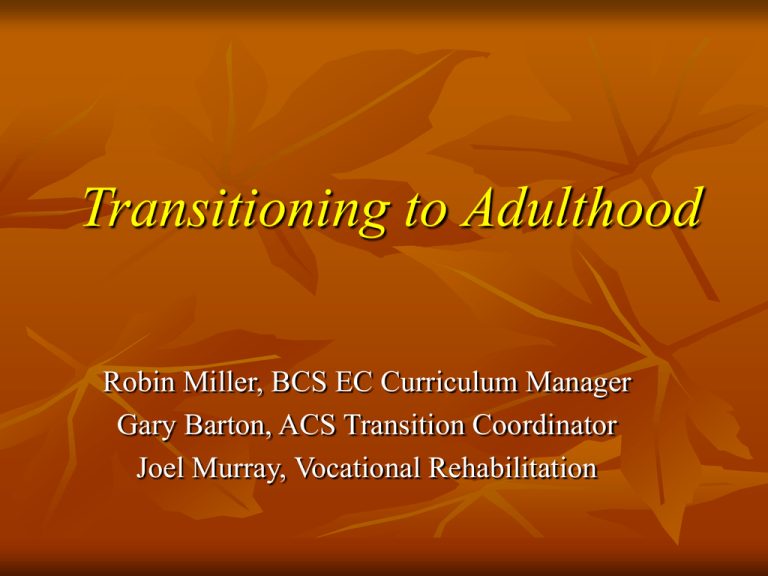
Transitioning to Adulthood Robin Miller, BCS EC Curriculum Manager Gary Barton, ACS Transition Coordinator Joel Murray, Vocational Rehabilitation What is Transition Defined as a “Coordinated set of activities that is… Designed to be within a results oriented process Focused on improving the academic and functional achievement of the child with a disability to facilitate the child’s movement from school to post-school activities Including Postsecondary education Integrated employment Continuing and Adult education Adult services Independent living or community participation The Transition Plan Drives the IEP Must be done BEFORE the IEP so that outcome goals and activities will be reflected in the IEP Consists of: Choosing an Appropriate Course of Study Outcome goals (for AFTER graduation) Transition Activities- Steps to take to reach outcome goals IEP goals to address skills that the student needs to learn Courses of Study For 9th Graders Entering 2009/2010 and later •Future - Ready Core For 9th Graders with IEPs entering 2000 and later •Occupational Course of Study For 9th Graders Entering Between 2000/2001-2008/2009 •College/University Prep •Career •College Tech Prep Graduation Requirements http://www.ncpublicschools.org/docs/curric ulum/home/graduationrequirements.pdf IEP teams can not alter Graduation requirements and have the student obtain a diploma Local Education Agencies (LEAs) can add additional local graduation requirements (Example: Buncombe County and Asheville City require 28 credits for graduation) Student Involvement is Critical Students need to be able to communicate their interests and preferences. IDEA requires them to attend – issued their own invitation. Students who have greater involvement in setting transition goals are more successful in achieving their goals. Actually, when possible, the student should be leading / direct their meeting. “Nothing about me without me” Parent Involvement is Critical Parents have insight & information unavailable to school personnel. Are a valuable source of information about the students strengths and needs. Parent “Buy-in” is essential to successful transition plans and accomplishment of student goals as goals focus on both in and out of school activities that lead to post-school success. Should have parents complete their own Transition Assessment Where do we begin? Student interests (Interest Inventories) Transition Assessment for parents Other Transition Assessments (Ability assessments, Personality styles, learning styles, etc..) Information from other agencies involved with the student Backward Planning Start with post school outcomes GOALS Think BACKWARDS as to what you would need to know or do (steps you would take) What steps would I need to take in order to reach my goals? Each “STEP” becomes an ACTIVITY that must be completed to reach the GOAL Who should attend the Transition Meeting? 1) 2) 3) 4) 5) 6) 7) 8) The STUDENT The PARENT(S) Sp. Ed. Teacher Local Education Agency representative (LEA) Regular Education Teacher Related service providers (if there are any) School Guidance Counselor Community Agency representative(s) esp. (Vocational Rehabilitation, Child and Family Team, Mental Health Support, Developmental Disabilities case manager/care coordinator etc..) Post-School Outcome Domains Employment – Where is the student going to WORK after graduation? How many hours? Post-School Education/Training – Where & how is the student going to continue to LEARN & develop skills after graduation? What are the options? Independent Living – How will the student LIVE and ACCESS the community as independently as possible Determining Goals (Outcomes) Must be STUDENT driven Based on student’s: Preferences P Interests I Needs Strengths N S Post-School Outcomes GOALS Goals that are written to express what they want to do AFTER high school. Goals that are based upon age appropriate transition assessments related to education, training, employment, and, when appropriate, independent living skills. All Goals MUST BE MEASURABLE – ones you can visually see have been accomplished Examples of Outcome/Goals After high school, Nellie will attend community college in order to obtain CNA I & CNA II certification. After high school, Sam will live at home while attending college & move into his own apartment upon completion. Early: After high school, Bill will work full-time in an area related to human services – Later: After high school, Bill will work in a supported employment mobile work crew in the area of custodial cleaning. Transition Activities Are the STEPS that need to be taken to ensure attainment of Outcome Goals Occur while student is in school Address something that the student, parent, school or agency does Usually cover only one year but can cover more than one. Address up to 7 areas Instruction - Related Services Community Experiences - Employment Adult Living Skills - Daily Living Skills Functional Vocational Evaluation Activity Areas to be addressed 1) 2) 3) 4) 5) 6) Instruction (formal strategies to teach a skill) Related Services (in-school + projected adult) Community Experiences (services & leisure act.) Employment (training & education needed for job) Adult Living Skills (skills used “as needed”) Daily Living Skills (required for day-to-day functioning) 7) Functional Vocational Evaluation Examples of Activities Instruction - Take required college admission test. Learn to use a communication device.* Related Services – Identify company to repair wheelchairs. Community Experience – Identify community transportation options Employment – Learn interviewing skills* Adult Living Skills – Set up a savings account Daily Living Skills – Learn basic budgeting skills* From Transition Goals to IEP Goals 2013 Learn Interview Skills PLP + Goals & Objectives 2014 Learn Job App. Skills PLP + Goals & Objectives 2015 Job Shad. & Apply Employment Outcome No goals for Shadow PLP + Goals for applications Additional Information NC State Acronyms Vocational Rehabilitation (VR) links and services http://www.ncpublicschools.org/docs/academicser vices/updates/asis-acronym.pdf http://dvr.dhhs.state.nc.us/DVR/links/links.htm Local Management Entity (LME) http://www.westernhighlands.org/ Questions??? For more information please contact Robin Miller: Buncombe County Schools EC Curriculum Manager (828) 255-5978 Robin.miller@bcsemail.org Gary Barton: Asheville City Schools Transition Coordinator (828) 337-4363 gary.barton@ashevillecityschools.net Myra Hill: Vocational Rehabilitation Region

